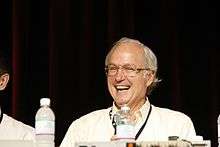Butler Lampson
| Butler Lampson | |
|---|---|
 Professional Developers Conference 2009 Technical Leaders Panel | |
| Born |
December 23, 1943 Washington, D.C. |
| Fields | Computer science |
| Institutions |
UC-Berkeley Xerox PARC DEC Microsoft MIT |
| Alma mater |
Harvard University (A.B., 1964) University of California, Berkeley (Ph.D., 1967) |
| Thesis | Scheduling and Protection in an Interactive Multi-Processor System (1967) |
| Doctoral advisor | Harry Huskey |
| Known for | SDS 940, Xerox Alto |
| Notable awards |
A. M. Turing Award (1992) IEEE John von Neumann Medal (2001) Draper Prize(2004) Computer History Museum Fellow (2006)[1] |
|
Website http://research.microsoft.com/en-us/um/people/blampson/ | |
Butler W. Lampson (born December 23, 1943) is an American computer scientist contributing to the development and implementation of distributed, personal computing. He is a Technical Fellow at Microsoft and an adjunct professor at MIT.
Biography
After graduating from the Lawrenceville School (where in 2009 he was awarded the Aldo Leopold Award, also known as the Lawrenceville Medal, Lawrenceville's highest award to alumni), Lampson received his Bachelor's degree in Physics from Harvard University in 1964, and his Ph.D. in Electrical Engineering and Computer Science from the University of California, Berkeley in 1967.
Works
During the 1960s, Lampson and others were part of Project GENIE at UC Berkeley. In 1965, several Project GENIE members, specifically Lampson and Peter Deutsch, developed the Berkeley Timesharing System for Scientific Data Systems' SDS 940 computer.
Lampson was one of the founding members of Xerox PARC in 1970, where he worked in the Computer Science Laboratory (CSL). His now-famous vision of a personal computer was captured in the 1972 memo entitled "Why Alto?".[2] In 1973, the Xerox Alto, with its three-button mouse and full-page-sized monitor was born.[3] It is now considered to be the first actual personal computer (at least in terms of what has become the 'canonical' GUI mode of operation).
All the subsequent computers built at Xerox PARC followed a general blueprint called "Wildflower", written by Lampson, and this included the D-Series Machines, the "Dolphin" (used in the Xerox 1100 LISP machine), "Dandelion" (used in the Xerox 8010 model of the Xerox Star and Xerox 1108 LISP machine), "Dandetiger" (used in the Xerox 1109 LISP machine), "Dorado" (used in the Xerox 1132 LISP machine), "Daybreak" Xerox 6085, and "Dragon" (a 4-processor 6085 with one of the first snoopy caches, though never released to production).
At PARC, Lampson helped work on many other revolutionary technologies, such as laser printer design; two-phase commit protocols; Bravo, the first WYSIWYG text formatting program; Ethernet, the first high-speed local area network (LAN); and designed several influential programming languages such as Euclid.
In the early 1980s, Lampson left Xerox PARC for Digital Equipment Corporation's Systems Research Center (SRC) In 2001, he left to work for Microsoft Research in Mountain View. That lab closed in 2014.
Lampson is an adjunct professor at MIT.
Honors and awards
- In 1992, he won the prestigious ACM Turing Award for his contributions to personal computing and computer science.[4]
- In 1994, he was inducted as a Fellow of the ACM.
- In 2001, he received the IEEE John von Neumann Medal.[5]
- In 2004, he won the Charles Stark Draper Prize along with Alan C. Kay, Robert W. Taylor, and Charles P. Thacker for their work on Alto.[6]
- In 2006 he was inducted as a Fellow of the Computer History Museum "for fundamental contributions to computer science, including networked personal workstations, operating systems, computer security and document publishing."[7]
Quotes
Lampson is often quoted as saying, "Any problem in computer science can be solved with another level of indirection," but in his Turing Award Lecture[8] in 1993, Lampson himself attributes this saying to David Wheeler.
See also
References
- ↑ Butler Lampson 2006 Fellow
- ↑ DigiBarn Computer Museum: Why Alto? Butler Lampson's Historic 1972 Memo
- ↑ Thacker, C.P.; McCreight, E.M.; Lampson, B.W.; Sproull, R.F.; Boggs, D.R. (1982), "Alto: a personal computer", Computer Structures: Principles and Examples: 549–572, retrieved 2010-09-02
- ↑ Levin, Roy. "Butler W Lampson - A.M. Turing Award Winner". Association for Computing Machinery. Retrieved 2 March 2016.
- ↑ "IEEE John von Neumann Medal Recipients". Institute of Electrical and Electronics Engineers. Retrieved 2 March 2016.
- ↑ "2004 Winners: Alan C. Kay, Butler W. Lampson, Robert W. Taylor, and Charles P. Thacker". National Academy of Engineering. Retrieved 2 March 2016.
- ↑ CHM. "Butler Lampson — CHM Fellow Award Winner". Retrieved March 30, 2015.
- ↑ http://research.microsoft.com/Lampson/Slides/TuringLecture.doc
External links
| Wikimedia Commons has media related to Butler Lampson. |
- Lampson's website
- The milliLampson unit
- Butler Lampson. Oral history interview, 11 December 2014, Cambridge, Massachusetts. Charles Babbage Institute, University of Minnesota